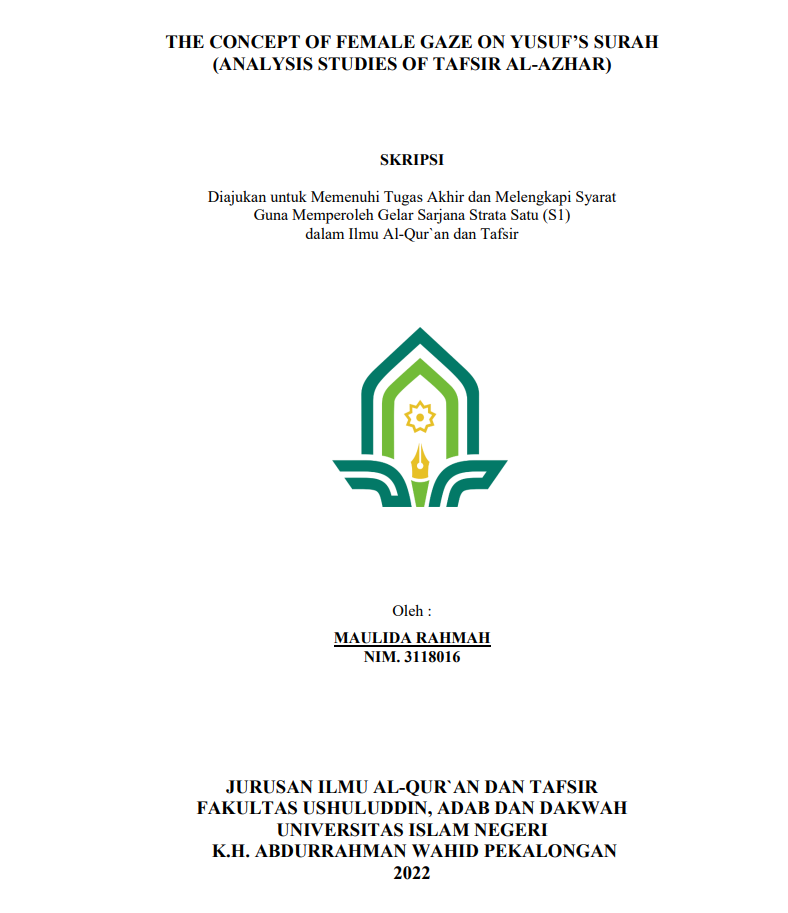
SKRIPSI IAT
The Concept Of Female Gaze On Yusuf's Surah (Analisis Studies Of Tafsir Al Azhar)
The emergence of the Female gaze theory was inspired by an essay written by a British theorist, Laura Mulvey, entitled Visual Pleasure and Narrative Cinema. This theory reconstructed Mulvey’s view of the male gaze in the media by providing the view that women can also take their own path in life without being influenced by anyone, one of which is knowing the expression of sexuality. There are some people who understand, if differently, that the decision to live according to the will of the woman herself without paying attention to some values, such as religious values, The problems of this research are: (1) How is the Hamka interpretation of Yusuf’s Surah, especially verse 23-24, 31 and 53; and (2) How is the relationship between the Female gaze concept and the Hamka interpretation in Yusuf’s Surah (verse 23-24, 31, and 53). The goal of this study is to (1) inform the reader about the Female gaze concept perspective in Hamka in Yusuf’s Surah; and (2) inform the reader about Hamka's contextual interpretation of the Female gaze concept. The significance of this research is (1) theoretical: it develops a treasury in the scientific field, especially informing the public about the concept of Female gaze in Yusuf’s Surah; and (2) practical: the research is hopeful to help answer the question of the meaning of Female gaze. This research uses a descriptive method with an approach qualitatively and is included in the type of library research. The collection of research data will be used for technique documentation. After data collection, a description-analysis will be carried out and related to the Hamka’s interpretations. This research used thematic analysis techniques for data analysis. The results that will be obtained from this research are: (1) Specifically in verses 23-24 and 53, Hamka explains that Zulaikha as a woman can also make decisions for her own life. Although in verses 23-24, the decision taken by Zulaikha is contrary to religious values and norms. While in verse 31, Hamka explains that the women invited by Zulaikha were very stunned by Yusuf’s good looks and almost hugged him. That interpretation of verses 23-24, 31 and 53 is related to Lacan’s psychoanalytic theory, which says that the signifier has an influence on the image, thus affecting a person’s understanding of an action or world. (2) The connection between verses 23-24 with Female Gaze is that Hamka interprets the words Hamma bih± and Hammat bih as a result of Zulaikha's act of teasing Prophet Yusuf with the intention of wanting to express Sukanya's feelings. Verse 31, Hamka interprets the word Akbarnahụ as a sense of extreme admiration for something beautiful. whereas in verse 53, Hamka interprets that Zulaikha has a mature soul because she asks Allah for forgiveness for what she has done.
Ketersediaan
| 23SK2331008.00 | SK IAT 23.008 FAJ t | My Library (Lantai 3, Local Content) | Tersedia |
Informasi Detail
- Judul Seri
-
-
- No. Panggil
-
SK IAT 23.008 FAJ t
- Penerbit
- Pekalongan : Jurusan S-1 Ilmu Al-Qur\'an dan Tafsir FUAD UIN K.H. Abdurrahman Wahid Pekalongan., 2023
- Deskripsi Fisik
-
xvi, 100 hlm., 30 cm; Bibliografi: 101-104
- Bahasa
-
Inggris
- ISBN/ISSN
-
-
- Klasifikasi
-
2X1.12
- Tipe Isi
-
-
- Tipe Media
-
-
- Tipe Pembawa
-
-
- Edisi
-
-
- Subjek
- Info Detail Spesifik
-
-
- Pernyataan Tanggungjawab
-
Maulida Rahmah (3118016)
Versi lain/terkait
Tidak tersedia versi lain
Lampiran Berkas
Komentar
Anda harus login sebelum memberikan komentar
 Karya Umum
Karya Umum  Filsafat
Filsafat  Agama
Agama  Ilmu-ilmu Sosial
Ilmu-ilmu Sosial  Bahasa
Bahasa  Ilmu-ilmu Murni
Ilmu-ilmu Murni  Ilmu-ilmu Terapan
Ilmu-ilmu Terapan  Kesenian, Hiburan, dan Olahraga
Kesenian, Hiburan, dan Olahraga  Kesusastraan
Kesusastraan  Geografi dan Sejarah
Geografi dan Sejarah